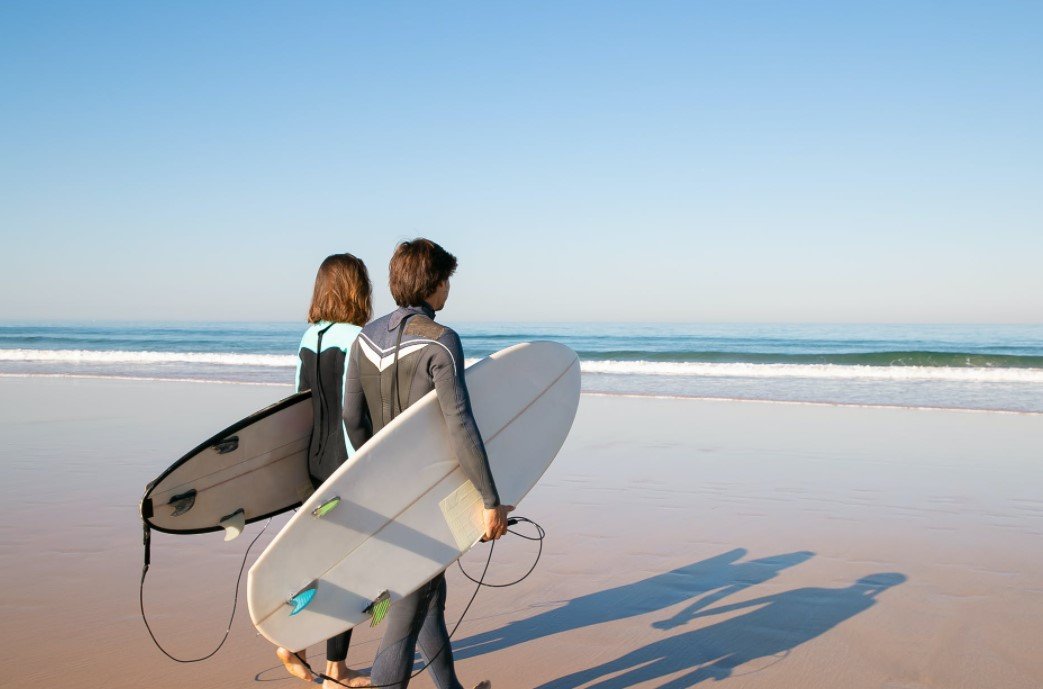A New Surfer’s Guide to Riding the Waves

You’ve been admiring people surfing for years anytime that you see them. Whether it’s on TV, in a movie, or with your own eyes at a beach, you’ve been jealous of those adventurous souls paddling out into the waves, catching one, and then riding them in.
Good on you if you’ve made the decision to join their ranks. Surfing is great exercise and even more fun. It’s also something you can take up at nearly any point in life if you’re in decent shape.
Even if you’re not in great shape to start with, you can certainly correct that. What’s also necessary, on top of proper conditioning, is knowing the ins and outs of being a new surfer.
Anticipating the Expenses
Surfing isn’t something cheap. Then again, it’s not overly expensive either if you’re careful. Anticipate spending money on the following things:
-Surfboard: Beginner foam boards hit the market around $350. Normal surfboards range from $400 up to $1000, while longboards range from $500 up to $1600.
-Lessons: Smaller markets might have lessons for $10 to $20, whereas bigger markets can see them go up to $70 per hour.
-Wetsuit: Crucial for cold-water surfing, wetsuits give you more time in the water before you freeze. Expect to spend $100 to $600.
-Surf Wax: You’ll smother this across the upper side of your board to keep your front foot stable so it doesn’t slip. Get the right version for the water temperature where you surf for under $5.
-Tail Pad: If you don’t get a soft-top, then you need this to keep your back foot stable so it doesn’t slip off of the board. Average costs for these hover around $40.
-Surf Leash: Ranging from $20 up to $50, a good surf leash is crucial to water safety. It keeps you from getting physically separated from the surfboard that you’re using.
Depending on your vehicle, you might also need to be some kind of rack or mount that can carry your board on the exterior when going to the beach or back home.
Transportation Matters
When it comes to transporting your surf board using your vehicle, you have two different ways of doing it with two choices in each category:
-Roof With Solid Rack: This is probably the most secure way of carrying your board around. Make sure the rack is mounted securely.
-Roof With Soft Rack: Soft racks don’t keep your board as secure. They will keep it from coming off of your roof, but vibrations and minor movements can happen.
-Inside the Vehicle: You’ll probably have to lower the backseat and passenger seat to slide the board in from the rear to push it in far enough to close the back of your vehicle.
-Open-Ended: If your board is too long, you might have to leave it sticking out of the end of your vehicle through an open window or tied-down door. Drive carefully.
Do note that some locales have specific laws that might prevent you from mounting something on the roof without a solid rack or driving around with your trunk open. Some places even refuse to let drivers go around with the surf board inside their vehicle all due to obstructions of view and movement. Always know and follow the local laws.
Safety Rules
Your surfing lessons will have many safety rules that you need to follow. However, here are three that you need to know right from the start:
Take Care of Your Board: Don’t skimp on the tail pad, wax, or surf leash. You’ll wind up in the water without catching a wave, and you’ll lose your board.
Respect the Locals: Every surfing spot has a crowd of locals with their own vibe. Some are territorial, whereas others are more open to visitors.
One Wave, One Rider: Whoever is deepest into the wave when it forms is the one that gets to ride it. Never double up, and wait your turn. It will come.
Basic Boarding Tips
There’s no substitute for lessons and experience, but here are a few basic boarding tips you can to start learning the fundamentals of catching waves.\
Practicing your pop-ups follows this process:
- Before you even get in the water, put your board in the sand, digging holes for the fins.
- Lay on your stomach, pressing the top of both feet into the board.
- Imitate paddling by raising your head and chest.
- Imagine the moment the wave starts lifting you and grip your board by your ribs to push up.
- Swing your feet up and under you so they land on the board.
- Twist your hips swinging your dominant foot to the front.
- This will feel hard and even awkward, but if you can’t do it on the beach, then you can’t do it in the water.
When in the water:
- Use turtle rolls instead of duck dives to get past the break.
- Pick a landmark on the land to keep your horizon steady and even when riding a wave.
You can’t just grab a board and head out into the water expecting to figure out surfing by trial and error if you’re new to it. Before you start surfing, you need to:
- Anticipate the likely expenses
- Be ready for the transportation details
- Know the safety rules
- Learn basic boarding tips
You might also want to schedule a visit with your primary care physician to get checked out before starting this fun form of exercise. A preventable injury could make you lose your interest or enthusiasm before you get truly adept and hooked. That would be a tragedy, especially if you just booked your surfing adventure at a Costa Rica luxury resort.











